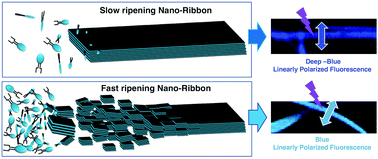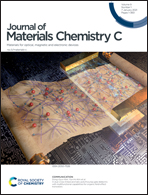Oriented attachment and activated dipoles leading to anisotropic H-bond-free self-assembly of n-acene derivatives into organic nanoribbons emitting linearly polarised blue light†
Abstract
The design of organic self-assembled nanomaterials requires a more complete understanding of all mechanisms leading to anisotropic and low-defect growth in solvent-processing, in particular in the vast case of polyaromatic compounds. 2,3-Dihexadecyloxy-9,10-diphenylanthracene (DPA16) self-assembles from solution into fluorescent nanoribbons without the addition of surfactants or polymers. These very high aspect-ratio anisotropic objects display a deep-blue emission with a remarkable linear polarisation P reaching a value of 0.6. The emission colour of ribbons can be further tuned by doping with a tetracene analogue. Crystallography, spectroscopy, atomic force and fluorescence polarisation microscopy techniques reveal that the growth mechanism not only involves a common ‘Ostwald ripening’, but also two commonly unforeseen features. First, an ‘oriented attachment’ mechanism contributes to the growth of the ribbons preventing packing mismatches. This mechanism has so far solely been demonstrated for inorganic nanoparticles. Second, a thermally activated dipole in less stable asymmetric conformations of DPA16 is proposed to contribute majorly to directional intermolecular interactions determining the main growth axis of the ribbons. These dipole–dipole interactions would contribute to explain the very high anisotropy of growth, in the absence of directional H-bonds predominating in many reported studies. This work provides new insights into the design of self-assembled nanoobjects with very high aspect ratios.



 Please wait while we load your content...
Please wait while we load your content...